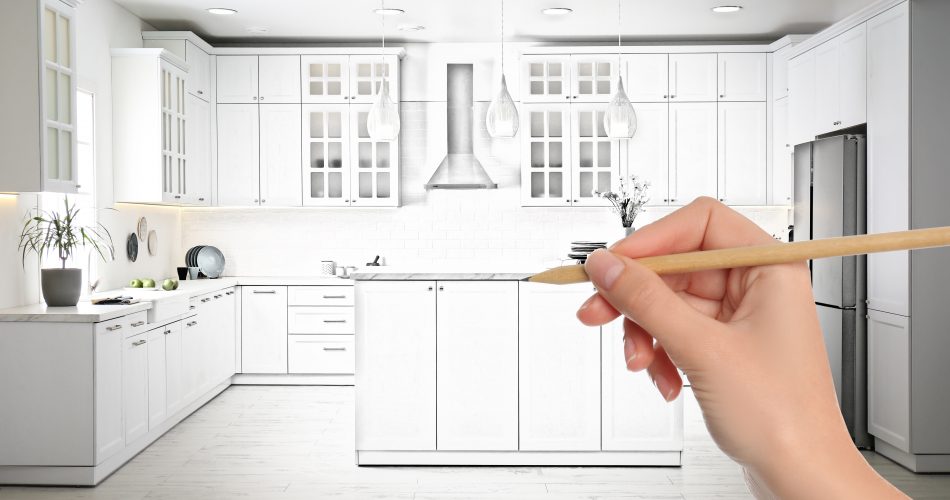Careful planning is a necessity when it comes to kitchen design. Whether you are going for a complete re-design and full renovation, or just some key improvements, your aim will be the same. At the end of the day, you want a better kitchen. You want your kitchen to look great aesthetically, but you also need to ensure that the kitchen is a highly functional space.
The modern kitchen is the hub of family living. Most people need a kitchen to be a space that works hard, plays hard, and looks good all the time. So, whether you are cooking or cleaning; eating or entertaining, your new, improved and better kitchen should be a space you love to be in.
Thoughtful kitchen design is the key to making this happen. Here are some great tips for a better kitchen.
Better Kitchen Tip #1: Eliminate wasted time and direct traffic carefully
It’s more of an issue in larger spaces, but our first tip is still worth considering whatever size your kitchen. This is especially true if you are designing a new kitchen from scratch. The best kitchens are efficient spaces. This means thinking carefully about how and where you use (or would like to use) items. For example, it makes sense to have breakfast foods and bowls positioned near to the breakfast bar. Similarly, try to place dishes, pots and pans near to the dishwasher. Anything that cuts down on wasted steps is worth doing and will lead to you creating a better kitchen space.
Similarly, especially in busy family homes, you should ensure that there is enough width between kitchen cabinets and the kitchen island. Any ‘walkway’ should be at least 36 inches wide. Leave even more space – at least 42 inches – for the actual cooking area. You also need to think about how to ‘direct traffic’ through and around the kitchen. For example, if there are young kids around, try to keep the main cooking areas out of the main walkways. Other items, such as the fridge, should be more accessible to all.
Tip #2: Attention to detail
It’s actually a catch-all tip when it comes designing a better kitchen but attention to detail is particularly important in certain areas. One such aspect is corners. These become critically important when deciding where to position cabinets, units and appliances. You need sufficient clearance and an appropriate swing direction. Avoid positioning appliances near to corners wherever possible. Similarly, you need to plan to ensure that doors won’t get in the way of each other if they happen to be open at the same time.
A similar attention to detail is required for things such as determining the correct height of the microwave. Obviously, this will depend on your individual and family needs. The optimum height for a microwave is about 15 inches above the countertop. However, if you want to make it more family-friendly, a position below the countertop might be a safer and more suitable option.
Another aspect of kitchen design where the devil is in the detail is if you are planning to include an island into the space. Function is far more important than form, so you should carefully consider how you intend to use the island before you settle on the design. For example, if you are planning to cook and eat at the island, you need to make sure there is enough distance between the hot cooking area and the dining space. Also, think about whether you want to add further functionality to the kitchen island, such as by including a sink.
Tip #3: Space, space, space
We’d all like a bit more space in the kitchen – or indeed anywhere in the home. Unfortunately, you cannot magic space out of thin air. However, you can make the most of what you have. And the key to doing making the most of the space you have is thinking carefully about what space you need and how you can use it.
‘Landing space’ is the area you place items on near to appliances while you are preparing food and cooking. Ideally, there should be at least 15 inches either side of an appliance, such as the cooker or fridge. Don’t forget that you also need adequate landing space near to smaller appliances too, such as the toaster or microwave.
Especially if you are designing your kitchen from scratch, think carefully about your day-to-day cooking habits. If you see yourself as a budding chef and love to spend time preparing meals, giving yourself as much countertop space as possible – particularly between the sink and cooker. However, if you tend to cook simple meals or don’t cook very often, you’ll probably be fine with a bit less counter space.
Tip #4: Think smarter and make life easier
When planning a kitchen design, you should do all you can to make your life easier in the kitchen. Keep things handy and accessible, from where you store your knives to how you recycle. Think ahead and consider how you can keep things simple and straightforward.
Try to organise items so they are easily within reach – especially ingredients or utensils you use a lot. Indeed, think about the whole family. You might want to place certain snacks or favourite foods on shelves that are within easy reach for the kids.
Traditionally, the fridge is the place that notes and reminders are stuck to. If that works for you, that’s fine. Alternatively, a well-placed chalkboard or whiteboard can be a useful addition.
Make sure you have plenty of handily positioned plug sockets. Consider all the countertop appliances and where you will be using them. You won’t want to be continually moving an appliance to plug it in in years to come.
Tip #5: Get the aesthetics right
Our tips so far have focused on the practicalities. It is so important that you get these things right. But, of course, the design aesthetics are really important too. Light, space and colour are a vital part of this. For example, wall-to-wall cabinets and units can appear heavy and overbearing. It’s best to incorporate design features that break things up, such as open shelving or glass doors.
Get the colour scheme wrong and it can ruin the space you have. Darker tones can have a shrinking effect on a small space, making it look even smaller and uninviting. Lighter colours and softer shades work best to make smaller rooms look bigger.
From a design point of view, it’s a great idea to choose a focal point for the kitchen. It could be the island, an eye-catching backsplash or brightly coloured units. Once you have your focus, complement the surrounding area with a couple of softer details.
Your path to a better kitchen
All in all, when planning a new kitchen, it’s critical that you consider not just the overall look and style, but also the day-to-day requirements of everybody in the household. For family homes, this means creating a space that can adapt and evolve, growing as your family grows. Choosing the right layout is obviously essential but what makes a layout ideal depends on type of environment you want to create.
So, that’s the key thing about charting your path to a better kitchen. Choose the style of design that suits your tastes and then carefully consider your needs. A kitchen is not just something that you look at, it is used and lived in. Making it the space you have and the design you choose work for your is really what it is all about.
These days, you have a multitude of options at your disposal when it comes to kitchen design. The starting point needs to the budget. Once you have decided how much you are prepared to spend, stick to that figure and work from there. From classic and traditional looks to cutting edge contemporary designs, the world is your oyster.
What’s more, there are so many ways that design tricks can be used to create the illusion of space and light in the kitchen – and many ways that solutions can be found for any potential problems or stumbling blocks you may encounter in your quest for your kitchen.
Of course, if you need any help or advice, our team of experts at Kitchen Warehouse are always on hand to share their experience and expertise. Get in touch and we will help you get your dream kitchen.





